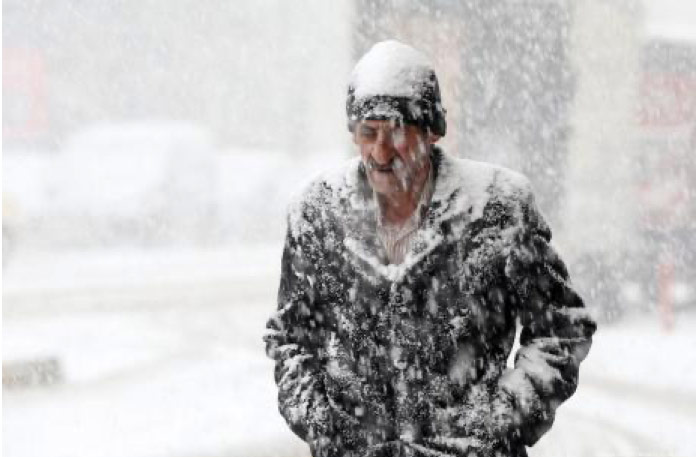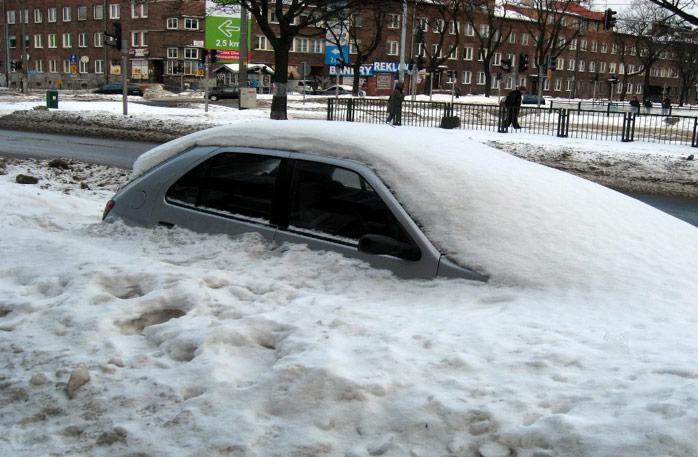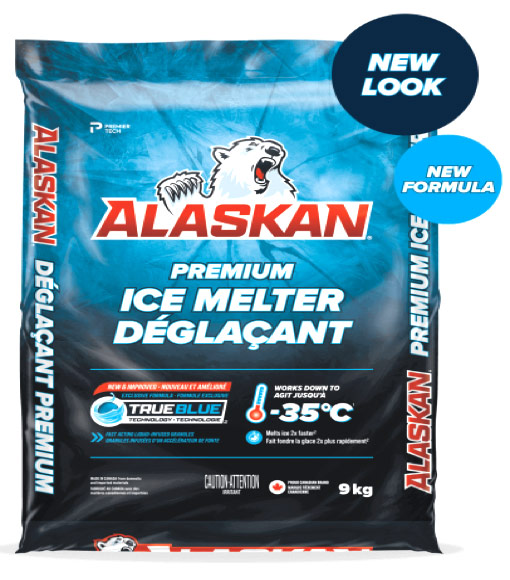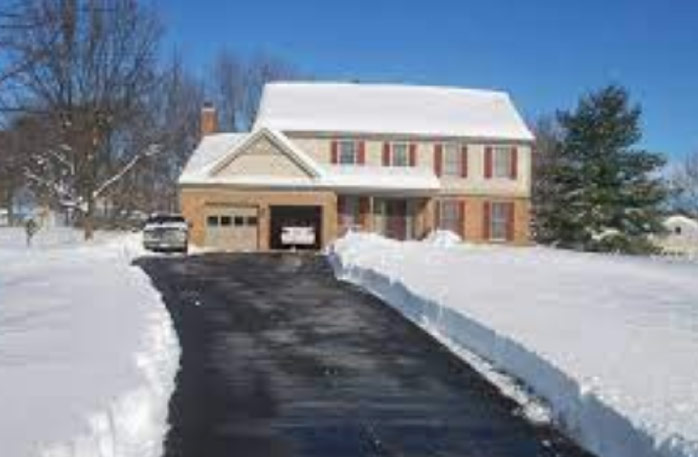Protect yourself and your family this winter — get deicers that really work!
Winter snow may be great for ski resorts, but for the 80% of Canadians who live in cities or their suburbs – it sucks
When winter comes, you have to buy special clothes. You have to put on layers of them. And take them off. And put them on again. And if the wind blows hard, you’re going to freeze anyway.

There’s no way of avoiding sinking up to your ankles in slush. Freezing your toes down to the bone.
You feel like you’re spending half your life digging your car out of huge drifts that snow cleaning operations have left behind. And they’re frozen, so it’s like you need a pickaxe, not a shovel, to free it.

And things get downright dangerous. Did you know that 30% of all collisions in Canada are due to wet or snowy roads in winter months?
What you don’t know can hurt you
It may surprise you, but did you know that one of the greatest dangers winter poses is the possibility of you slipping and falling and injuring yourself?
More than 9,000 Canadians every year end up in hospital because they slip on ice.
I know. Because it happened to me. I was picking up groceries from the trunk of my car after the sun had gone down. I couldn’t see the glare ice that was hidden by a thin covering of snow. But my feet could feel it.
They started losing purchase. Instead of realizing the potential danger of the situation, I did what every other winter idiot does. I figured I could sort of slip-slide-skate my way out.
Boy was I wrong! My feet kept slipping and slipping and suddenly I went head over heels and landed flat on my back.
I didn’t get hospitalized, but nearly. I merely had to deal with 9 weeks of really lousy sleep because of bruised ribs.
Not to mention having every breath accompanied by a wince of pain.
And you can imagine how worried I was about getting a cold. Coughing and sneezing would be daily torture.
It got to the point that I would avoid going out with friends because I was afraid that I would start to laugh. And hurt myself even more.
And this accident happened just 10 feet from my front door!
So what can we do? The good news is there is a solution. But it isn’t rock salt!
When most Canadians face difficult winter conditions like snow and ice, their fallback solution is rock salt.
Why? Because that’s what we’ve been doing for generations, and old habits die hard. What’s more, when we venture out in snowy conditions, what do we see? Municipal trucks spreading rock salt and sand on highways and roads. And, of course, we assume: If it’s good enough for highways, rock salt must be good enough for my driveway.
Well, here’s the big secret: Rock salt alone isn’t good enough!
Rock salt just doesn’t work that well as temperatures fall. At 0 ͦC (32 ͦF), 1 lb of rock salt will melt 46 lb of ice. But at -6.6 ͦC (20 ͦF), rock salt works much more slowly, and 1 lb will only melt 8.6 lb of ice. That’s an 81% drop in efficiency!
What’s more, if the sun is shining, its warm rays will help rock salt melt ice and snow. But what happens when the sun goes down and temperatures drop? The leftover liquid will freeze into glare ice. So rock salt ends up creating the very problem it was intended to eliminate.
IF YOU LIVE IN A PLACE WHERE THE TEMPERATURE FALLS BELOW – 4 ͦC (25 ͦF), ROCK SALT JUST WON’T CUT IT. YOU NEED TO FIND ANOTHER SOLUTION!
This is the solution for effective deicing
What is it? It’s one of nature’s uncommon wonders. It works as a firming agent to firm soybean curds into tofu. It’s used as an electrolyte in sports drinks. It’s employed to flavour pickles without raising their salt content. On dirt roads, it’s very useful in settling dust. And it’s an extremely effective deicer.
It’s calcium chloride! The deicer of choice.
In its pure form, it can work at temperatures as low as −52 °C (−62 °F).
Here’s the deal. When it’s used as a deicer, calcium chloride usually comes in solid form, but it’s deliquescent. That’s a fancy way of saying that it easily turns into a liquid when it comes in contact with snow and ice. You want this. This liquid creates an exothermic reaction. And that’s just a fancy way of saying that it releases heat. A lot of it. That’s what melts snow and ice. And you definitely want this.
Are you in a hurry and is ice slowing you down?
When your driveway is snowed in or iced over, speed is also of the essence. Calcium chloride melts up to eight times as much ice as does salt alone – within the first 30 minutes at -7 °C (20 °F) following application.
Which calcium chloride deicer should I buy?
The deicer that works best is Alaskan® Premium Ice Melter Its new formula is effective at temperatures as low as -35 ᵒC (-31 ᵒF), turning ice and snow into easy-to-remove slush in minutes. No other brand on the market in Canada can make this claim.

There’s no way of avoiding sinking up to your ankles in slush. Freezing your toes down to the bone.
You feel like you’re spending half your life digging your car out of huge drifts that snow cleaning operations have left behind. And they’re frozen, so it’s like you need a pickaxe, not a shovel, to free it.
And things get downright dangerous. Did you know that 30% of all collisions in Canada are due to wet or snowy roads in winter months?
What you don’t know can hurt you
It may surprise you, but did you know that one of the greatest dangers winter poses is the possibility of you slipping and falling and injuring yourself?
More than 9,000 Canadians every year end up in hospital because they slip on ice.
I know. Because it happened to me. I was picking up groceries from the trunk of my car after the sun had gone down. I couldn’t see the glare ice that was hidden by a thin covering of snow. But my feet could feel it.
They started losing purchase. Instead of realizing the potential danger of the situation, I did what every other winter idiot does. I figured I could sort of slip-slide-skate my way out.
Boy was I wrong! My feet kept slipping and slipping and suddenly I went head over heels and landed flat on my back.
I didn’t get hospitalized, but nearly. I merely had to deal with 9 weeks of really lousy sleep because of bruised ribs.
Not to mention having every breath accompanied by a wince of pain.
And you can imagine how worried I was about getting a cold. Coughing and sneezing would be daily torture.
It got to the point that I would avoid going out with friends because I was afraid that I would start to laugh. And hurt myself even more.
And this accident happened just 10 feet from my front door!
So what can we do? The good news is there is a solution. But it isn’t rock salt!
When most Canadians face difficult winter conditions like snow and ice, their fallback solution is rock salt.
Why? Because that’s what we’ve been doing for generations, and old habits die hard. What’s more, when we venture out in snowy conditions, what do we see? Municipal trucks spreading rock salt and sand on highways and roads. And, of course, we assume: If it’s good enough for highways, rock salt must be good enough for my driveway.
Well, here’s the big secret: Rock salt alone isn’t good enough!
Rock salt just doesn’t work that well as temperatures fall. At 0 ͦC (32 ͦF), 1 lb of rock salt will melt 46 lb of ice. But at -6.6 ͦC (20 ͦF), rock salt works much more slowly, and 1 lb will only melt 8.6 lb of ice. That’s an 81% drop in efficiency!
What’s more, if the sun is shining, its warm rays will help rock salt melt ice and snow. But what happens when the sun goes down and temperatures drop? The leftover liquid will freeze into glare ice. So rock salt ends up creating the very problem it was intended to eliminate.
IF YOU LIVE IN A PLACE WHERE THE TEMPERATURE FALLS BELOW – 4 ͦC (25 ͦF), ROCK SALT JUST WON’T CUT IT. YOU NEED TO FIND ANOTHER SOLUTION!
This is the solution for effective deicing
What is it? It’s one of nature’s uncommon wonders. It works as a firming agent to firm soybean curds into tofu. It’s used as an electrolyte in sports drinks. It’s employed to flavour pickles without raising their salt content. On dirt roads, it’s very useful in settling dust. And it’s an extremely effective deicer.
It’s calcium chloride! The deicer of choice.
In its pure form, it can work at temperatures as low as −52 °C (−62 °F).
Here’s the deal. When it’s used as a deicer, calcium chloride usually comes in solid form, but it’s deliquescent. That’s a fancy way of saying that it easily turns into a liquid when it comes in contact with snow and ice. You want this. This liquid creates an exothermic reaction. And that’s just a fancy way of saying that it releases heat. A lot of it. That’s what melts snow and ice. And you definitely want this.
Are you in a hurry and is ice slowing you down?
When your driveway is snowed in or iced over, speed is also of the essence. Calcium chloride melts up to eight times as much ice as does salt alone – within the first 30 minutes at -7 °C (20 °F) following application.
Which calcium chloride deicer should I buy?
The deicer that works best is Alaskan® Premium Ice Melter Its new formula is effective at temperatures as low as -35 ᵒC (-31 ᵒF), turning ice and snow into easy-to-remove slush in minutes. No other brand on the market in Canada can make this claim.
Even better, if you spread the Premium Ice Melter before a storm, it will prevent snow and ice from forming a bond with the underlying surface. This makes snow and ice removal, if not a breeze, at least much easier.
Don’t let winter hold you back!
No matter where you live in Canada, winter can make your life miserable. Traffic gets snarled. You get into work late. You get home late. That’s assuming you can get home at all because – look, your car just got towed because it was in a snow-removal zone.
What’s worse, winter can make life downright dangerous. Winter collisions are simply a fact of life for most Canadians. And that’s not even taking into account injuries resulting from slipping and falling in inclement conditions.
Much of this is preventable, especially when it comes to what happens around the home. Get an effective deicer with calcium chloride to protect you and your family from slipping (and perhaps hurting themselves!) due to snow and ice on driveways and sidewalks. The same products will make sure you get on your way and about your business quickly and efficiently.
Click here to find out more about effective deicers containing calcium chloride.

This is what winter should look like. Get the picture?